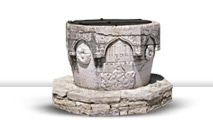
- Sečovlje Salt Pans - Dragonja River Valley
- Sv. Peter - Nova vas - Padna
- Pomjan - Nature Park: Karst Edge - Socerb
- Črni Kal - Osp - Kubed
- Momjan - Grožnjan - Pietrapelosa - Mirna
- Baštija - Kostanjica - Parenzana
- Oprtalj - Završje - Livade - Zrenj
- Istarske toplice - Motovun Forest - Višnjan
- Cave Mramornica - Feštini Kingdom - Cave Baredine
- Lim Bay - Kloštar - Kontija - Dvigrad
- Kanfanar - Bale - Palud - Vodnjan - Brijuni - Fažana
- Svetvinčenat - Tinjan - Pićan - Gračišće
- Belaj - Šumber - Kožljak - Paz
- Čepićko Field - Kršan - Boljun Castle - Lupoglav
- Plomin - Kvarner Gulf - Brseč
- Nature park Učka - Mošćenice
Kanfanar - Bale - Palud - Vodnjan - Brijuni - Fažana
Brijuni
One of the most beautiful national parks in Croatia, the place where history in combination with natural beauties created gorgeous scenery, leaving every visitor speechless. In the past, just like today, it is equally impressive and overwhelming.
The Brijuni Islands covering an area of 33.9 sq kilometers are separated from the mainland by the 3-kilometer-wide Fažana Channel. The archipelago, consisting of 14 islands and islets, the largest of which are Veli and Mali Brijun, lies northwest of Pula.
The first traces of human existence date from the 3rd millennium BC. At that time the population of Brijuni engaged in agriculture, cattle breeding, hunting and fishing. They made their weapons and tools from stone and bones, testified by the Neolithic settlement of semi-subterranean sod houses in Soline Bay. After the Roman period, from the 6th - 8th cc. the islands, as well as Istria came under Byzantine rule. This was followed by Frankish rule for a time, then the Patriarchs of Aquileia, and from the 14th c. Venetian rule. Over the centuries the islands were neglected, and the inhabitants left Brijuni due to the frequent ravages of malaria. Brijuni turned over a new leaf at the end of the 19th c. when the islands were bought by the industrialist P. Kupelwieser who turned them into a fashionable seaside resort. Brijuni then became an unavoidable tourist destination, also proved by the fact that the German Emperor Wilhelm II visited Brijuni as many as six times. Besides members of royal families, many other distinguished persons stayed on Brijuni, where they promoted the leisurely life of luxury, enjoyed playing polo, golf and tennis, so the islands were ranked among the world's trendiest places. The two-kilometer-long water supply system below the Fažana Channel was constructed for the purpose of supplying water from the mainland. For the purpose of tourism, archaeological sites and parks were arranged. The splendor of nature is represented by over 680 native and exotic plant species and 150 species of birds.
Brijuni abound with cultural and historical monuments, the most notable and best preserved of which are the luxurious Roman villa from the 1st/2nd c. with thermae and Temple of Venus, Byzantine castrum, basilica of St. Mary from the 5th/6th c. and the Church of St. German from the 15th c.

















